Colour in Victorian magazines
There are many instances of hand-coloured plates in magazines for illustrating topics such as gardening and dress fashions that go back to at least the start of the 1800s. However, colour printing in magazines in Britain appears to have started in 1855. Yet, whereas the Victorians pioneered many aspects of the global periodicals industry, they were slow to expand the use of colour, particularly on popular weekly magazines. Four types of technology have dominated magazine colour printing:- block printing (1850s to 1890s, this page);
- chromolithography (1850s onwards, this page);
- photogravure (from 1914);
- offset lithography (from 1960).
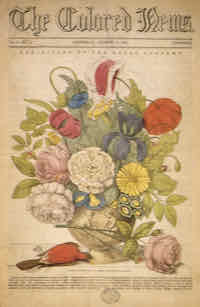 The Colored News (1855) |
The Colored News (1855)Weekly, from August 4. Only 9 issues. Colour from wood blocks |
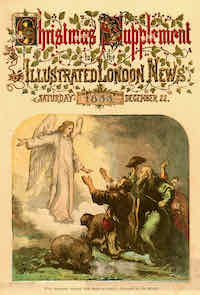 Illustrated London News (1855) |
Illustrated London News (1855)Weekly. Tabloid (280 × 400 mm). December 22 supplement with a colour cover produced using woodblocks and etching; three colour pages inside. Printed by Leighton Bros of Lambs Conduit St, London. Sales of 130,000 a week, 10 times the daily sales of The Times. As colour became more affordable it was used more frequently: for example, the 15 February 1879 issue carried a colour supplement for St Valentine’s Day |
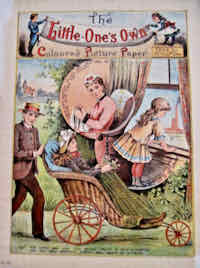 Little One’s Own Coloured Picture Paper was launched in 1855. This is issue 48 |
Little One’s Own (1855)The Little One’s Own Coloured Picture Paper was Britain’s first regularly wholly chromolithographed periodical |
Better chromolithographyThis was a period of fast development is all sorts of technologies, which were reported in the daily and Sunday papers. Under the heading 'The Fine Arts', the Sunday Times carried news of an improved lithographic colour-printing (chromolithography) process by Mr Nicholson, of Ball-yard, Gracechurch-street in London. It describes a print of 'Fishing Boats off Calais', a watercolour by J. Herbert, saying: 'The chief peculiarity of Mr Nicholson's process consists in the pouching of the surface of the stone upon which the subject is delineated, which enables him to produce more perfectly defined outlines, and a much greater breadth and brilliancy of tone than has hitherto been obtained by stone-printing.' The article goes on to say that, 'if the water-colour original and the chromo-lithograph were placed side by side, it would puzzle many, and not bad judges either, to distinguish the one from the other.' The technique was aimed at fine art prints, rather than magazine printing, but is shows the work going on to reduce costs. The writer credits Nicholson with reducing the number of stones, and of coloured impressions by a third, bringing 'some of the choicest specimens of art within reach of persons of very moderate means'. (December 21 1856, page 2) |
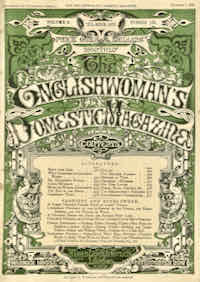 Englishwoman's Domestic Magazine (1860) |
Englishwoman’s Domestic Magazine (1860)Monthly. 1s. A5-ish. Samuel and Isabella Beeton imported colour fashion plates from Paris. The Rijksmuseum reproduces the magazine's fashion plate from February 1861 (and plates from other sources). It identifies the printer as Legastelois and Fanguet, the publisher as Ad. Goubaud et Fils, from a drawing by Jules David (1808-1892). The technique was gravure with hand colouring (202mm high by 130mm) |
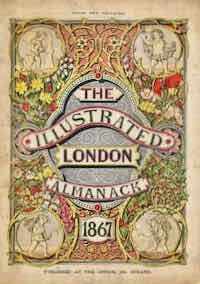 Illustrated London Almanack from 1867 |
Illustrated London Almanac(k) (1860s)1s annual Switched from wood wood-engravings to relief-etched plates. In 1873, switched to chromolithography. Published at the office of the Illustrated London News, 198 Strand |
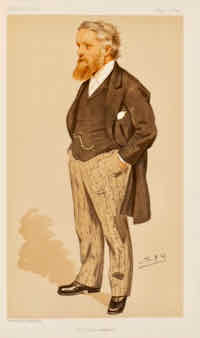 Vanity Fair launched in 1869. This Spy caricature of George Newnes is from the issue of 8 May 1894 |
Vanity Fair (1869)Weekly. Tall A4 Full-page colour caricature plate printed by chromolithography in each issue |
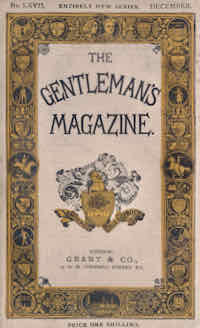 Gentleman's Magazine. December 1873 issue with second colour highlighting illustrated border 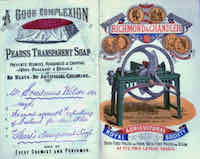 Two pages of colour advertising in July 1877 issue |
Gentleman's Magazine (1873)Monthly. 1s. Grant and Co.Orange second colour on cover. |
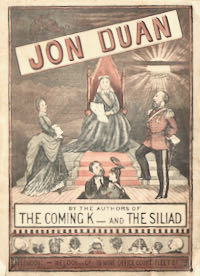 Jon Duan (1874) 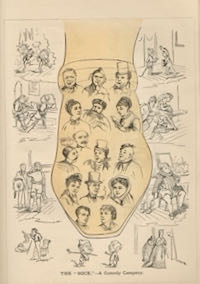 There were four pages like this that used spot colour
There were four pages like this that used spot colour |
Jon Duan (1874)Annual. 1s. Weldon and Co.Colour cover with several bound-in plates, four of them with a tint over part of the sheet |
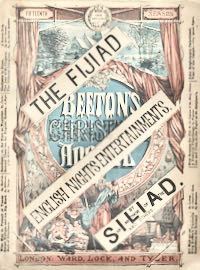 Fijiad, Beeton’s Christmas Annual (1874) |
Fijiad, Beeton’s Christmas Annual (1874)The Fijiad, Beeton’s Christmas annual. 1s Ward, Lock and Tyler. Colour cover and several bound-in plates, none of them coloured |
Frank Leslie’s Popular Monthly (US)Frank Leslie’s Popular Monthly (New York) Monthly.From its first issue (January 1876) includes a chromolithograph |
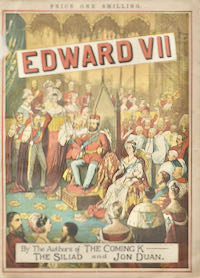 Edward VII 1876 annual |
Edward VII (1876)Annual 1s. Weldon and Co.Coloured cover. Notice to advertisers on a half-title page: ‘The original intention of publishing Edward VII on December 15th, 1875 (or before Christmas), had to be abandoned, owing to the large number of copies ordered by the public and the booksellers. Even with all the new appliances, and perfection in machinery, it was impossible to supply the demand before today.’ There were several inserted plates, including some foldouts, none of them coloured |
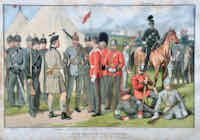 Boy’s Own Paper colour plate from 1881 |
Boy’s Own Paper (1879)1d weekly. 6d for monthly part. Colour plates produced with relief printing. Chromolithography began to dominate from 1880. Process engraving from 1900s |
 Tit-Bits launched in 1881. This is the green advertising wrapper in 1888 |
Tit-Bits (1881)Weekly. A4-ish. 1d George Newnes title establishes model for cheap popular weeklies. No colour. Green wrapper later introduced to carry advertising. Pearson’s Weekly (crimson) and Answers (yellow/'golden') follow suit |
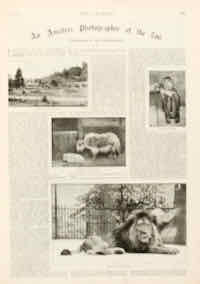 The Graphic (5 September 1885). First halftones |
First halftones (1885)Weekly. Reproduces first half-tones in reportage article about visiting London Zoo |
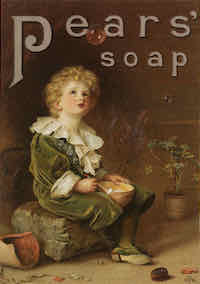 Illustrated London News (1880s). 'Bubbles' by Millais was given away as a chromolithographic print; and the idea was taken up by Pears' soap |
Illustrated London News 'Bubbles'1880s Chromolithograph prints of paintings given away with issues |
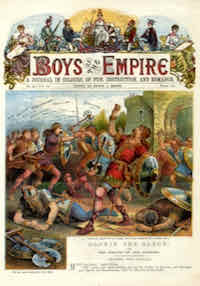 Boys of the Empire (21 January 1889). Chromolithograph |
Boys of the Empire (1888)Weekly comic. |
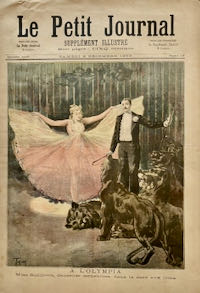 Petit Journal, issue of 2 December 1893 |
Le Petit Journal Supplément Illustré 1890Weekly. ParisFirst mass market colour supplement in France. Spin-off Sunday supplement from Le Petit Journal, which was probably the world's best-selling newspaper at the time. Used presses designed and built by Hippolyte Auguste Marinoni |
| |
Land and Water 18902 August. 3-colour collotypes printed by Waterlows, London |
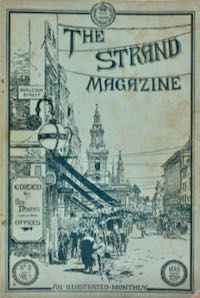 The Strand, March 1891 (no. 3) |
The Strand 1891George Newnes. 6d. Monthly. No colour |
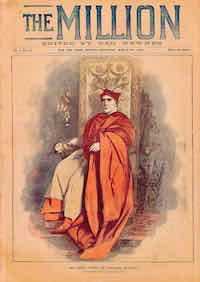 The Million: first issue of the groundbreaking popular weekly in 1892 |
The Million (1892)George Newnes. Weekly penny tabloidBritain's first mass market colour weekly. Based on Le Petit Journal Supplément Illustré, which was a huge success in France. Newnes bought presses from its owner, Marinoni |
1892 colour halftoneLand and Water prints coloured halftone (13 February 1892) |
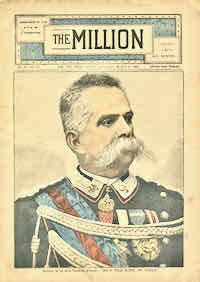 The Million 1893 smaller format |
The Million 1893 small formatGeorge Newnes. Weekly penny tabloid. A4, 24pp. 1d.Three-col covers and centre spread. ‘Comic format’ |
 Chums cover masthead from 1894 |
Chums 1893Weekly. 6d. CassellBoy's weekly starts giving away colour plates from 30 August 1893. Printed in Britain and bound into the magazine from printing plates made by Husnik and Hausler in Prague |
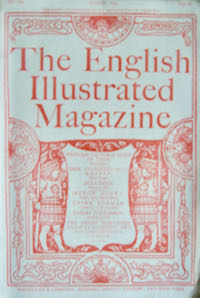 English Illustrated Magazine 1893 |
English Illustrated (1893)Monthly 6d Prints line-illustrated cover in pink-red, rather than black |
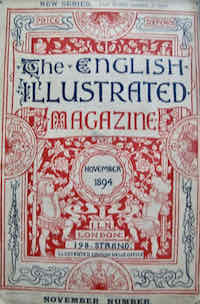 English Illustrated Magazine 1894 |
English Illustrated (1894): 2-col coverMonthly 6d.Cover in two colours, red and blue |
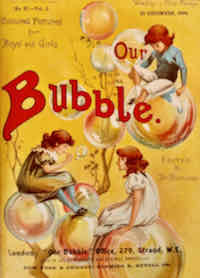 Our Bubble 1894 |
Our Bubble 1894Monthly. Christmas special 1894.Our Bubble: Coloured Pictures for Boys and Girls was edited by Dr Barnardo and was one of several publications he published between 1874 and 1900 to raise funds for his children’s homes. Four weekly issues, costing a penny each, were collated with a supplement each month and sold for sixpence. A chromolithograph was added to the Christmas part. The monthly parts were then gathered as an annual volume entitled Our Bubbles. |
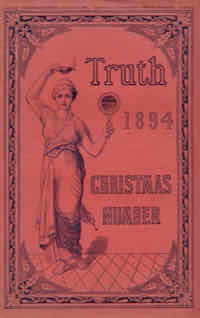 Truth Magazine with coloured paper for Christmas 1894 |
Truth (1894)Monthly. 1s (12d)Tall A4 Christmas number. Double-pages coloured plates printed separately and inserted into issue |
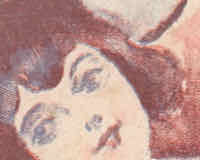 The Hour, 1895. Detail of two-colour cover 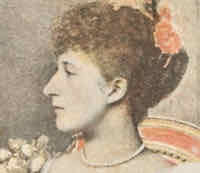 Detail of coloured photograph Detail of coloured photograph |
The Hour (1895)6d. Large format. Two colours (no black) on front and back covers. One or two spot colours on 7 pages. Cover illustration, ‘The spirit of the hour’, by HA Beard (Luna) |
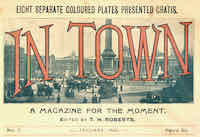 In Town Magazine titlepiece 1895 |
In Town 1895Monthly. Tall A3. ‘Eight separate coloured plates presented gratis.’ In this case, 'coloured' meant the full-page illustrations and photographs were printed in a single colour, other than the usual black. Some other pages were printed with a spot colour |
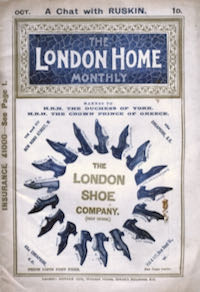 London Home Magazine 1895 |
London Home 1895Monthly. 1d. Large A5.October issue used blue and gold inks for masthead and advertising on its front, back and inside covers |
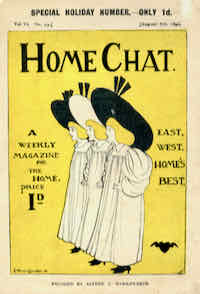 Home Chat, 8 August 1896 |
Home Chat 1896Weekly. 1d. Large A5. Two-colour cover: yellow and black |
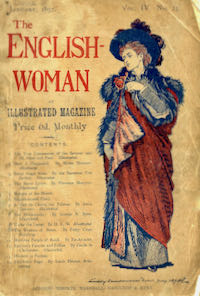 The Englishwoman 1897 |
The Englishwoman 1897Monthly. 6d Large A5.Two-col cover: red and blue |
Illustrated London News 1897Diamond Jubilee number in chromolithography around 12 colours, including gold |
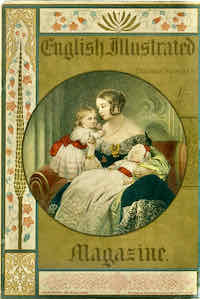 English Illustrated Magazine 1897 |
English Illustrated Magazine 1897Monthly. 1s.Christmas double issue cover in several colours, including gold, with the blue used on the back cover for advertising. Four bound-in mezzotint plates of Queen Victoria, one a photograph, by Rembrandt Intaglio |
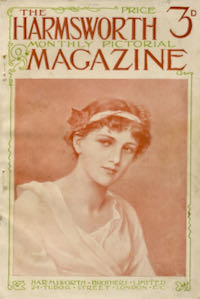 Harmsworth Magazine, July 1898. First issue |
Harmsworth Magazine 1898Monthly. 3d. Large A5 First issue (July)Two-colour cover using subtle shades. Rival to The Strand at half the price |
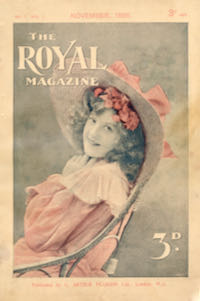 Royal Monthly, November 1898. Coloured Lallie Charles photograph for first issue |
The Royal 1898Monthly. 3d. Large A5 First issue (Nov). Two-colour cover |
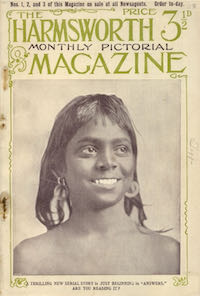 Harmsworth Magazine, November 1898. Photographic cover – the teeth appear to have been whitened |
Photographic cover, 18983½d. Large A5. Two-colour cover with photograph |
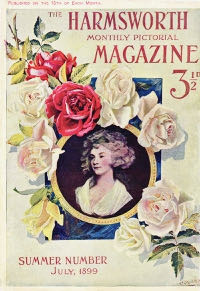 Harmsworth Magazine 1899 |
Harmsworth Magazine 18993½d. Large A5 3-col coverRed, yellow and blue inks overlaid give an approximation of black |
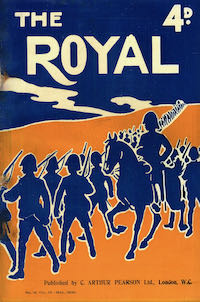 Royal Monthly 1900 |
Royal Monthly 19004d. Large A5 2-col.Strong graphic cover |
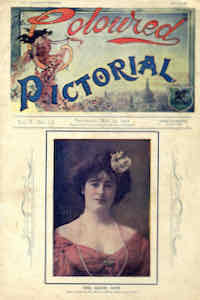 Coloured Pictorial 1902 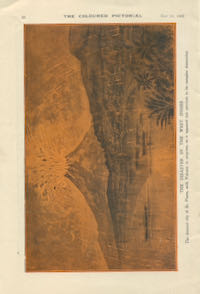 Illustrations such as this volcano eruption in the West Indies were in two colours |
Coloured Pictorial 1902Weekly. Sub-A4, 32pp + iv. 1d.Three-colour covers and inside covers (advertising). Coloured photographs on cover. Eight coloured pages, including centre-spread and two pages overprinted with second cover |
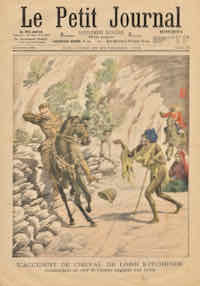 Petit Journal 1903. Kitchener's riding accident in India is front-page news in France |
Le Petit Journal 1903Weekly French coloured tabloid still with original 1890 format |
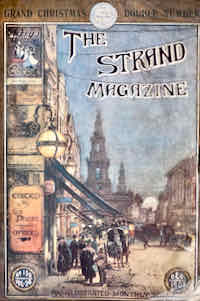 The Strand 1903 |
The Strand 1903Large A5. George Newnes.The Strand, founded in 1891, and the most successful monthly of the era, ran this Christmas colour cover in 1903. US colour covers had been run for several years, and not just at Christmas. |
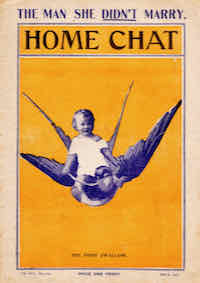 Home Chat 1905 cover with imagine manipulation combining photograph and illustration |
Image manipulation in 1905Weekly. 1d. Large A5. Two-colour cover: yellow and blue. A photograph of a young child has been cut out and combined with an illustration of a bird for this cover: 'The first swallow' |



